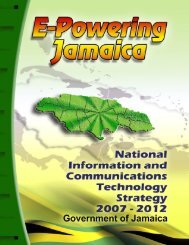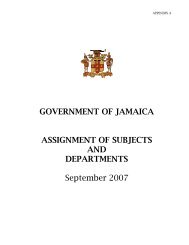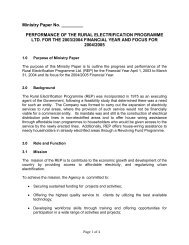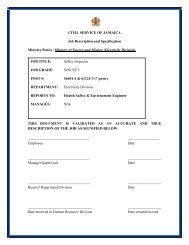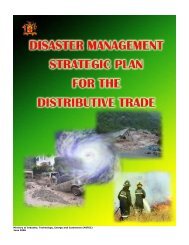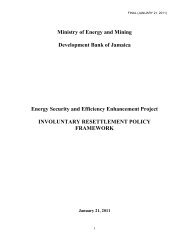Jamaica Biofuels Report - Ministry of Energy
Jamaica Biofuels Report - Ministry of Energy
Jamaica Biofuels Report - Ministry of Energy
You also want an ePaper? Increase the reach of your titles
YUMPU automatically turns print PDFs into web optimized ePapers that Google loves.
Pilot Projects: Discussion <strong>of</strong> Other Sugarcane SitesMoneymuskThe pilot project evaluation for Frome has similar application to Moneymusk, where the sugar caneharvest in 2006 was 760,000 tons, compared to 897,000 tons at Frome. Since the new owners <strong>of</strong>Moneymusk, following divestiture by the Sugar Company <strong>of</strong> <strong>Jamaica</strong>, will also be able to supply canefrom lands that were previously within the Bernard Lodge catchment area, the available sugar caneharvest after new investment and rationalization is likely to exceed that <strong>of</strong> Frome. As a result, anddependent on decisions by the new owners, a scheme similar to that described for Frome withcomparable benefits and returns, is an option. As at Frome, lengthening the cane harvest season (213days in 2006) and increasing biomass fuel supplies (bagasse and possibly purpose grown) for a newcogeneration plant will be desirable to maximise returns from the new investments. As the cane seasonis extended, water supply for irrigation will grow in significance. Options will need to be explored to usemore efficient methods <strong>of</strong> irrigation (e.g. drip feeding) and possibly cultivation <strong>of</strong> sweet sorghum as analternative to sugar cane in the early/late harvest periods. The other key factor is an appropriatepayment for electricity sales that recognizes the full savings in imported fuel that electricity from a newcogeneration plant would provide. Both <strong>of</strong> the preceding are essential for a commercial success andhence for a decision by the new owners to invest.Long Pond (Trelawny)The Pilot project evaluation for Duckenfield, which had a total sugar cane harvest <strong>of</strong> 331,000 in 2006, isalso applicable to Long Pond, where the 2006 sugar cane harvest was 338,000 ton. However, oneimportant difference needs to be noted, and that is the longer and more pronounced dry season in thecatchment area <strong>of</strong> Long Pond compared to Duckenfield, as shown in Figure 3. This is important, becausein order to justify the investment needed to convert an existing a sugar mill to one producing ethanoland electricity (the pilot concept for Duckenfield), it is necessary to find ways to extend the harvestseason to secure high availability from the new plant. Another problem at Long Pond is the loss <strong>of</strong>catchment areas due to its proximity to the rapidly developing tourist areas <strong>of</strong> the north coast. So eventhough Sweet Sorghum might be considered as an alternative to sugar cane and require less water, landfor this crop will be less easy to obtain and secure in the long term.An alternative that Long Pond may wish to consider is to just to invest in higher efficiency cogenerationbased on sale <strong>of</strong> electricity to the <strong>Jamaica</strong>n grid. This requires less investment, but again, it is most likelyto be attractive when the operating period <strong>of</strong> the new plant can be extended to most <strong>of</strong> the year ratherthan being restricted to the current length <strong>of</strong> the cane harvest.Worthy ParkThis privately-owned site already has a highly integrated production <strong>of</strong> sugar and rum, and the canecatchment area has little room for expansion. As a result, the main option that Worthy is considering isinvestment in a more efficient cogeneration plant that would allow it to sell elecricity to the grid. Thiswill only be possible if OUR finds a way to give full recognition to the value that this type <strong>of</strong> projectwould provide in terms <strong>of</strong> avoided imports <strong>of</strong> fossil fuel.DuckenfieldAs an alternative to conversion from sugar to ethanol production, Duckenfield could remain a sugarproducer, but by adding a modern cogeneration plant, it could also become an electricity supplier to thegrid. The economics <strong>of</strong> this is likely to require finding a way to extend the cane harvesting season and99



